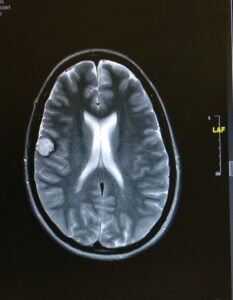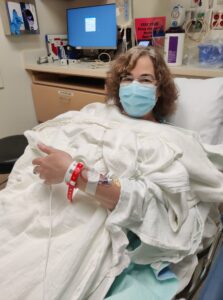My CCM story started with brief, odd sensations behind my eyes, in my early 40s. The sensations occurred once every few months and were fleeting, so it didn’t occur to me to mention anything to a doctor. 
Over time, I noticed that my eyes felt like they needed to squeeze shut every time this sensation passed through. I concentrated hard each time it started, trying to figure out exactly what was happening and how to describe it, but I could not put my finger on how to put it into words.
More than a year later, I finally attempted to explain the strange sensations to various general practitioners (GPs). Each time, they asked if I had headaches or other symptoms accompanying my sensations. Because my answer was “No,” each GP dismissed my symptoms as nothing to worry about. Some suggested my symptoms were a stress-related tic.
These symptoms continued for years. Over time, the frequency of the episodes increased, and the nature and location of my symptoms shifted from my eyes to my mouth, including tingling sensations, wavering chin, loss of sensation, or paralysis of my upper lip. Each episode lasted about 30 seconds. With increasing frequency and changing location, I was growing more and more certain that something was definitely wrong. Once again, I brought my concerns to a GP, but this time, I directly requested a referral to a neurologist.
The neurologist asked the same questions about headaches and other symptoms, and based on my response, said he didn’t think an MRI was necessary. However, he agreed to refer me for an MRI since it “seemed important to me.” This response was infuriating and disconcerting. It was so clear to me that something was wrong; why was it not clear to any of my doctors?
For various reasons, it was months before I finally got the diagnostic MRI. I was stunned to learn that 1) there was a mass in the fronto-parietal cortex of my brain which the neurologist believed was a cerebral cavernous malformation (CCM), 2) my “episodes” were actually probably sensory and motor seizures, and 3) there was evidence that the CCM had been oozing micro-amounts of blood into my brain.
I was truly dumb-founded. Everything felt surreal. I had never heard of CCM or sensory seizures. No one in my family had a history of neurological conditions. And now I had a referral to an epilepsy center and a neurosurgeon?!
That was the weekend of March 6-7, 2020.

The very next week, the first COVID-19 lockdown went into effect. My referrals to the epilepsy specialist and neurosurgeon went nowhere for a few weeks, as departments were not taking new appointments, doctors were not seeing patients, and people were told to avoid hospitals due to high COVID rates.
A few months later, I suffered a new bleed. My seizures grew intensely painful, lasted 20-40 minutes each, and began occurring hourly. Due to the pandemic, all my care had been conducted remotely, and patients were still being told to stay away from hospitals unless they had COVID or a dire emergency. My condition was not considered a dire emergency. I suffered many days and sleepless nights in pain and was no longer able to work. Thanks to my sister’s advocacy, I finally was admitted for a 48-hour EEG observation. The EEG showed nothing, despite the fact that I continued to have extremely painful seizures throughout the day and night.
Between seizures, the brain bleed, medication side effects, the stress of starting a new job in isolation, and the many layers of stress the pandemic generated, my cognitive abilities declined significantly. Retaining new information was a struggle and spending eight hours each day learning a new job from a small laptop screen was brutal. After only six months at my new job, I had to resign from my position.
A few months later, after four hours of attending to personal business at the computer, I walked away from the screen with cascading seizures, one rolling into the next, continuing for hours into the night and throughout the following days. This new level of seizure forced my eyes closed for 5-7 seconds at a time. While I was fully conscious and otherwise able-bodied, random eye shutting episodes rendered me unsafe for driving and I was no longer able to tolerate even brief exposure to computers or TV screens.
Meanwhile, since being diagnosed with CCM, I had several misadventures with anti-seizure medications, barely tolerating unsustainable side effects on doses too low to effectively thwart my seizure activity. The worst medication trial landed me in the Emergency Department (ED) with extreme shortness of breath, ataxic limbs, and muscles too weak to support standing or walking, probably due to medication-induced hyponatremia (sodium deficiency.) It was while sitting in the ED bed, one year after diagnosis, that I finally realized brain surgery might be my only viable ticket out of the misery and sharp decline my quality of life had taken.
In July 2021, feeling hopeful with my new choice, I underwent a craniotomy for cerebral cavernous malformation resection. The surgery was quite successful and I felt very little pain, however, plummeting post-operative sodium levels made recovery slow and difficult.

Six months after the surgery, changing medications for the fifth time since diagnosis changed the course of my recovery dramatically. Without the medication side effects I had previously struggled with, my stamina, energy, memory, and mental acuity increased substantially. I also credit vision therapy for my recent, marked improvements. Vision therapy retrains visual processing skills and helps re-integrate the visual with the vestibular system, all of which had been thrown out of alignment with the bleed and intense seizures at the eyes.
Now, eleven months after surgery, being on the right dose of the right medication and pursuing vision therapy, craniosacral therapy, and good nutrition, I feel more and more like myself, with sharpened cognitive function, vitality, and a sense of hope for my future.

